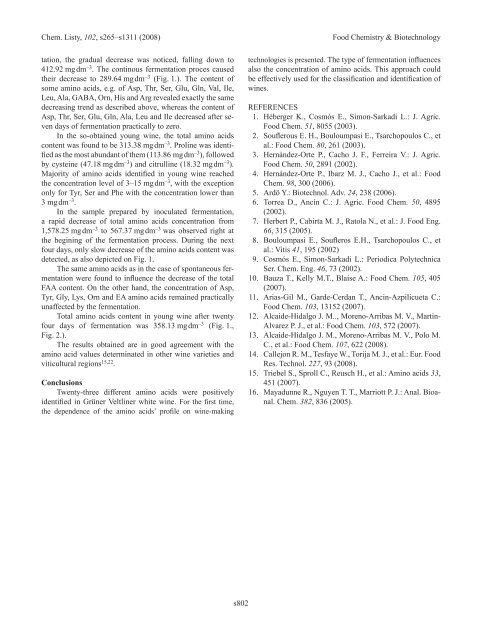3. FOOD ChEMISTRy & bIOTEChNOLOGy 3.1. Lectures
3. FOOD ChEMISTRy & bIOTEChNOLOGy 3.1. Lectures
3. FOOD ChEMISTRy & bIOTEChNOLOGy 3.1. Lectures
You also want an ePaper? Increase the reach of your titles
YUMPU automatically turns print PDFs into web optimized ePapers that Google loves.
Chem. Listy, 102, s265–s1311 (2008) Food Chemistry & Biotechnology<br />
tation, the gradual decrease was noticed, falling down to<br />
412.92 mg dm –3 . The continous fermentation proces caused<br />
their decrease to 289.64 mg dm –3 (Fig. 1.). The content of<br />
some amino acids, e.g. of Asp, Thr, Ser, Glu, Gln, Val, Ile,<br />
Leu, Ala, GABA, Orn, His and Arg revealed exactly the same<br />
decreasing trend as described above, whereas the content of<br />
Asp, Thr, Ser, Glu, Gln, Ala, Leu and Ile decreased after seven<br />
days of fermentation practically to zero.<br />
In the so-obtained young wine, the total amino acids<br />
content was found to be 31<strong>3.</strong>38 mg dm –3 . Proline was identified<br />
as the most abundant of them (11<strong>3.</strong>86 mg dm –3 ), followed<br />
by cysteine (47.18 mg dm –3 ) and citrulline (18.32 mg dm –3 ).<br />
Majority of amino acids identified in young wine reached<br />
the concentration level of 3–15 mg dm –3 , with the exception<br />
only for Tyr, Ser and Phe with the concentration lower than<br />
3 mg dm –3 .<br />
In the sample prepared by inoculated fermentation,<br />
a rapid decrease of total amino acids concentration from<br />
1,578.25 mg dm –3 to 567.37 mg dm –3 was observed right at<br />
the begining of the fermentation process. During the next<br />
four days, only slow decrease of the amino acids content was<br />
detected, as also depicted on Fig. 1.<br />
The same amino acids as in the case of spontaneous fermentation<br />
were found to influence the decrease of the total<br />
FAA content. On the other hand, the concentration of Asp,<br />
Tyr, Gly, Lys, Orn and EA amino acids remained practically<br />
unaffected by the fermentation.<br />
Total amino acids content in young wine after twenty<br />
four days of fermentation was 358.13 mg dm –3 (Fig. 1.,<br />
Fig. 2.).<br />
The results obtained are in good agreement with the<br />
amino acid values determinated in other wine varieties and<br />
viticultural regions 15,22 .<br />
Conclusions<br />
Twenty-three different amino acids were positively<br />
identified in Grüner Veltliner white wine. For the first time,<br />
the dependence of the amino acids’ profile on wine-making<br />
s802<br />
technologies is presented. The type of fermentation influences<br />
also the concentration of amino acids. This approach could<br />
be effectively used for the classification and identification of<br />
wines.<br />
REFEREnCES<br />
1. Héberger K., Cosmós E., Simon-Sarkadi L.: J. Agric.<br />
Food Chem. 51, 8055 (2003).<br />
2. Souflerous E. H., Bouloumpasi E., Tsarchopoulos C., et<br />
al.: Food Chem. 80, 261 (2003).<br />
<strong>3.</strong> Hernández-Orte P., Cacho J. F., Ferreira V.: J. Agric.<br />
Food Chem. 50, 2891 (2002).<br />
4. Hernández-Orte P., Ibarz M. J., Cacho J., et al.: Food<br />
Chem. 98, 300 (2006).<br />
5. Ardö Y.: Biotechnol. Adv. 24, 238 (2006).<br />
6. Torrea D., Ancín C.: J. Agric. Food Chem. 50, 4895<br />
(2002).<br />
7. Herbert P., Cabirta M. J., Ratola n., et al.: J. Food Eng.<br />
66, 315 (2005).<br />
8. Bouloumpasi E., Soufleros E.H., Tsarchopoulos C., et<br />
al.: Vitis 41, 195 (2002)<br />
9. Cosmós E., Simon-Sarkadi L.: Periodica Polytechnica<br />
Ser. Chem. Eng. 46, 73 (2002).<br />
10. Bauza T., Kelly M.T., Blaise A.: Food Chem. 105, 405<br />
(2007).<br />
11. Arias-Gil M., Garde-Cerdan T., Ancin-Azpilicueta C.:<br />
Food Chem. 103, 13152 (2007).<br />
12. Alcaide-Hidalgo J. M.., Moreno-Arribas M. V., Martin-<br />
Alvarez P. J., et al.: Food Chem. 103, 572 (2007).<br />
1<strong>3.</strong> Alcaide-Hidalgo J. M., Moreno-Arribas M. V., Polo M.<br />
C., et al.: Food Chem. 107, 622 (2008).<br />
14. Callejon R. M., Tesfaye W., Torija M. J., et al.: Eur. Food<br />
Res. Technol. 227, 93 (2008).<br />
15. Triebel S., Sproll C., Reusch H., et al.: Amino acids 33,<br />
451 (2007).<br />
16. Mayadunne R., nguyen T. T., Marriott P. J.: Anal. Bioanal.<br />
Chem. 382, 836 (2005).

















